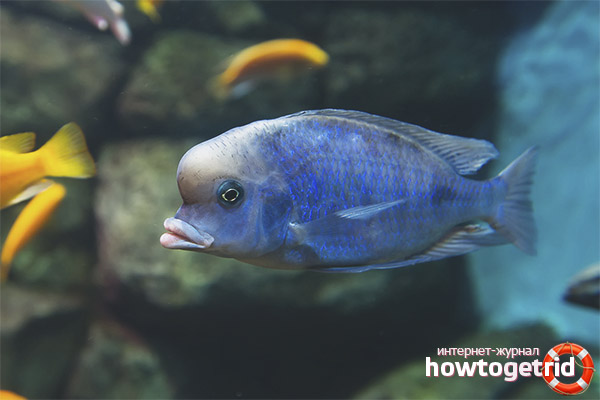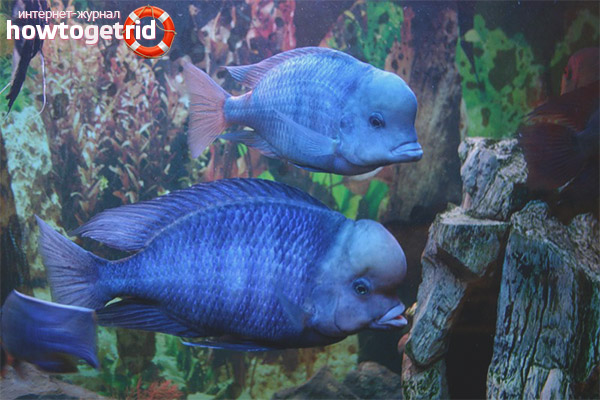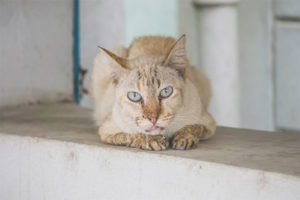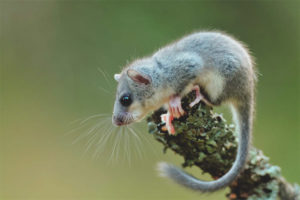The content of the article
Blue dolphin (Cyrtocara moorii) should be attributed to aquarium cichlids. It came from the African lake of Malawi. Its popularity is mainly due to the color and unusual shape of the body, on which there is a large fat cone. It is very difficult to call this representative very small, since he can grow in length in captivity up to 25 cm. Sometimes sizes can also take on large sizes. The fish are peaceful, but the males are quite aggressive and often engage in fights between themselves.
The most acceptable is a harem in which there are three females per male. In such a society, they live on their territory. It is subject to zealous protection only during the period when the fish spawns. Subsequently, a pronounced tolerance is manifested in relation to its territory.
The content of the blue dolphin is not associated with any difficulties. They only need a spacious container with clean water. For soil, it is better to use sand. At the bottom, it is necessary to lay various objects that will serve as a shelter. But free space should also be enough.
Being in the wild
The place of discovery of this species is Boulange. It happened in 1902. The endemic habitat is the African lake of Malawi, where this species is found throughout its territory. Fish gather in schools and can be at a depth of 15 m.
This representative can be safely ranked among predators. They will certainly swallow everything that comes in their way. Of course, if the size of production allows this to be done. By the end of the seventh decade of the last century, this representative was relocated to the aquarium. The body shape of the fish is elongated, vaguely reminiscent of a dolphin. On the head is a massive cone of fat. It grows in length to 25 cm. On average, life expectancy is up to 10 years.
Complexity of content
They should select their neighbors with particular care. Despite the fact that this representative has a peaceful character, not the best option is to keep them in a common aquarium. The best neighbor for them will be the African catfish.
Principles of feeding
This predator has a pronounced omnivorous. It uses a variety of benthos for its nutrition. Being in captivity, the fish will eat everything that they are offered, including artificial and live food. Regardless of nutrition, a sufficient amount of protein must be present in it. To this end, they are offered a tubule or artemia.
You can use a small fish as nutritious food, but only when there is complete confidence in the health of the living substrate intended for the feed. Do not feed minced meat for a long time, as this can lead to obesity. In addition, dystrophy phenomena associated with internal organs may develop.
Care Rules
Determining the content are volumetric indicators of capacity. It should be no less than 300 liters. Another nuance in importance is the degree of purity and stability of water characteristics. The natural habitat is associated with alkaline waters, which have a pH of 8.0 and a temperature of about 28 degrees. Water must be hard.If natural water in the region is soft, then measures are taken to increase its hardness. This can be done by adding coral chips. There is an opinion that inappropriate water parameters adversely affect the functions of the organ of vision of fish. But this has no scientific confirmation.
Sand should serve as a soil. The fish just loves to rummage through it. Characteristically, the fish does not need plants at all. Even if they are present, the fish will certainly dig them up or eat them. It is better if large stones are present in the sand. You can add any other large shelter to the bottom.
Neighborhood with other representatives
The fish has a fairly pronounced peacefulness, but, despite this, the general content is clearly not suitable for these representatives. If her neighbor is the same in size with her, then she will get along quite well with him. It is quite another thing when she meets a small fish. She perceives it simply as food and easily swallows it. An excellent neighborhood will be with fronts, African catfish.
It is very difficult to distinguish fish by sex. You can, of course, do this on a cone on your head, but in order for it to fully grow, it will take several years. The coloration of males is somewhat brighter than females. However, such differences are very relative.
Breeding basics
This representative has a pronounced polygamy. There are three females per male. Sometimes their number can reach 6 copies. Since the determination of sex is quite difficult, it is possible to purchase fry in the amount of 10 pieces and carry out their joint rearing. When the body length reaches 15 cm, the fish is considered sexually mature. During this period, they should be divided.
Masonry is carried out in the place that will be selected by the male. In order for the female to lay eggs, the male digs a hole in the sand. It is possible that any stone will be chosen by the male. Then he invites a female to this place. She lays eggs in a prepared place, which will be fertilized by the male. Female eggs are incubated in the mouth. She is able to place eggs in her mouth in an amount of up to 90 pieces.
The incubation period is 2-3 weeks. It depends on the temperature that the surrounding water has. After the fry appear, she also puts them in her mouth at night for safety reasons. The same phenomenon can be observed in case of imminent danger. Fry growth is extremely slow. At the initial stage, brine shrimp is used as food for fry. On this all the wisdom of fish farming of this representative ends.
Of course, the content of these fish is not entirely suitable for beginners, since it involves constant monitoring of the quality and temperature parameters of water. This is more familiar to the power of experienced lovers of aquarium exotic. Although, with certain efforts, beginners can also breed them.
The main thing in keeping is the spaciousness and purity of water. If the water is too soft, then measures should be taken to increase the hardness. Another point is the proper selection of neighbors. Ideally, it is better to keep these fish separately.
Video: blue dolphin aquarium fish











Submit